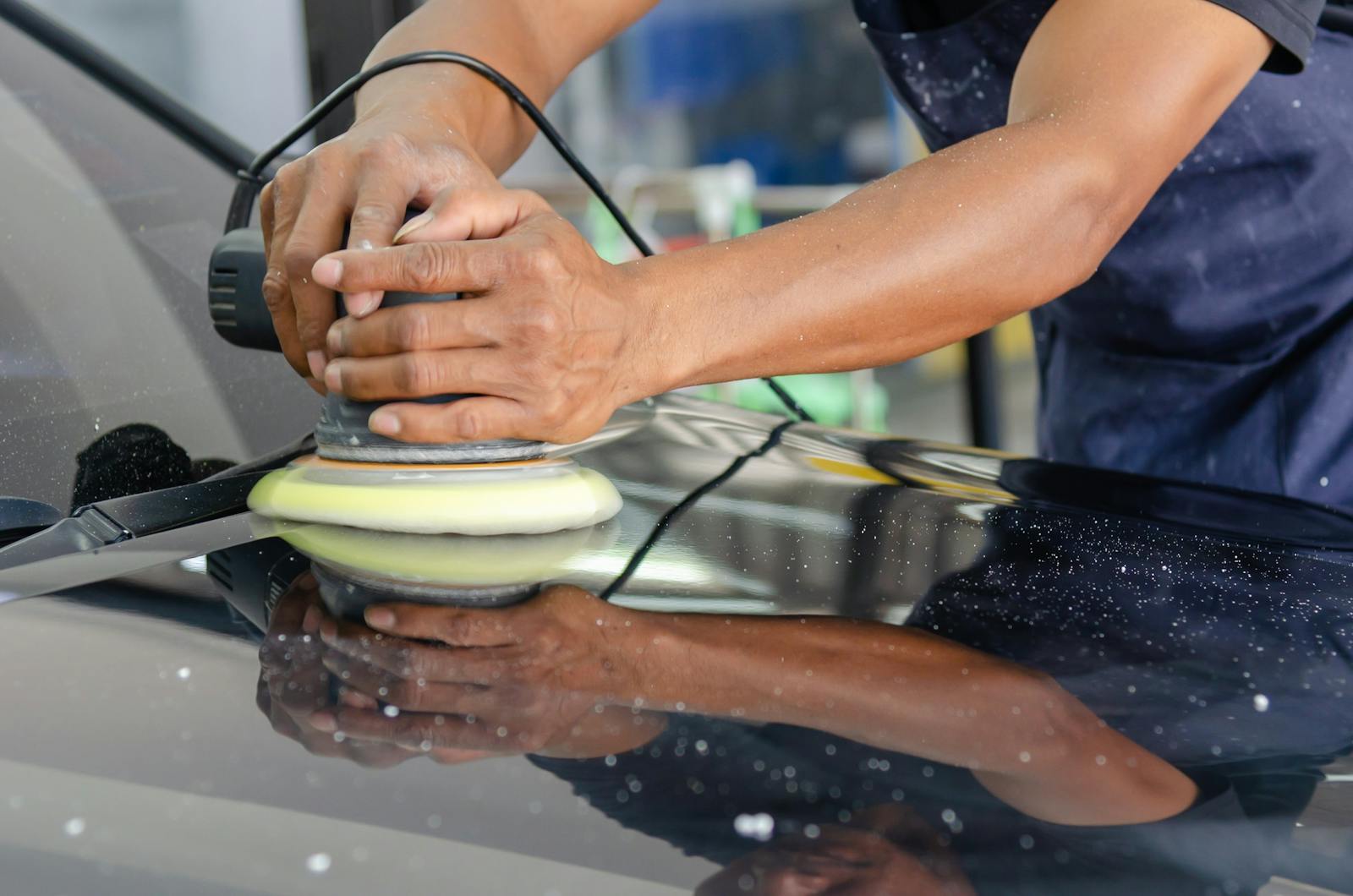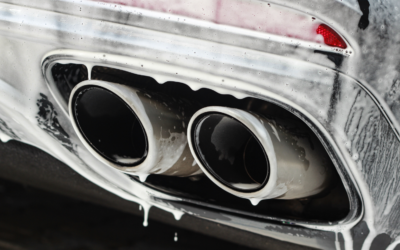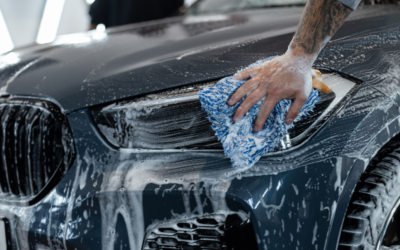Car enthusiasts face a common dilemma: after spending hours perfecting their vehicle’s finish with wax or ceramic coating, should they wash their car afterward? This question sparks heated debates in detailing communities and leaves many wondering if they’re undoing their hard work.
The short answer is more nuanced than you might expect. While you shouldn’t immediately wash your car after applying wax or coating, proper post-application care is essential for maximizing protection and achieving that coveted glossy finish. Understanding when and how to wash after waxing depends on several factors, including the type of product used, environmental conditions, and your vehicle’s specific needs.
This comprehensive guide will explore the science behind car waxing and coating, reveal the optimal timing for post-application washing, and provide expert tips to help you maintain your vehicle’s protective layer while preserving its showroom shine. Whether you’re working with traditional carnauba wax, synthetic paste wax, or advanced ceramic coating, you’ll discover the best practices that professional detailers use to achieve flawless results.

Photo by Tima Miroshnichenko on Pexels
Understanding Car Wax and Protective Coatings
Car wax serves as a sacrificial barrier between your car’s paint and harsh environmental elements. Traditional waxes, particularly carnauba wax derived from Brazilian palm trees, create a warm, deep shine while offering moderate protection against UV rays, bird droppings, and tree sap. These natural waxes typically last 2-3 months under normal driving conditions.
Modern synthetic waxes and spray wax formulations provide longer-lasting protection, often extending 4-6 months between applications. Chemical Guys and Turtle Wax offer popular synthetic options that bond more effectively to painted surfaces than their natural counterparts. These products excel at creating water beading effects and protecting against minor scratches and swirl marks.
Ceramic coating represents the pinnacle of paint protection technology. Unlike traditional waxes that sit on the surface, ceramic coatings chemically bond with your car’s paint at the molecular level. This creates an incredibly durable protective layer that can last 2-5 years with proper maintenance. Ceramic coatings provide superior UV protection, chemical resistance, and hydrophobic properties that make cleaning significantly easier.
The key difference lies in how these products cure and bond to your vehicle’s surface. While wax fills microscopic imperfections and creates a smooth surface, ceramic coating actually hardens into a semi-permanent layer that becomes part of your paint system.
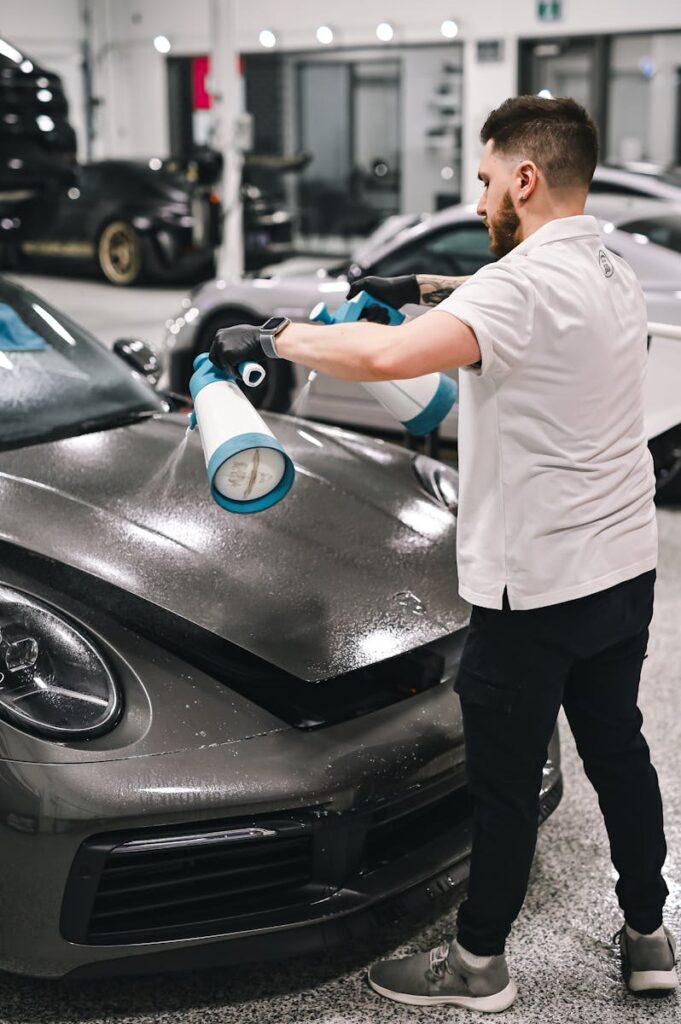
Photo by WAVYVISUALS on Pexels
The Science Behind Wax Curing and Bonding
Understanding the curing process is crucial for determining when it’s safe to wash your freshly waxed or coated vehicle. When you apply wax in circular motions using a microfiber cloth, you’re depositing a thin layer of protective material onto painted surfaces. This layer needs time to properly bond and achieve maximum durability.
Traditional paste wax typically requires 15-30 minutes to haze before removal with a clean microfiber towel. However, the bonding process continues for several hours after application. Environmental factors such as temperature, humidity, and direct sunlight significantly influence curing times. Hot, sunny conditions accelerate the process, while cool, humid weather extends it.
Spray wax formulations cure much faster, often becoming wash-safe within 1-2 hours of application. Their lighter consistency and solvent-based carriers allow for quicker bonding to the car’s surface. Many quick detailer products can be applied and immediately buffed off with a damp microfiber towel.
Ceramic coatings require the most patience. Professional-grade coatings may need 12-24 hours before light exposure to moisture and up to 7 days for full curing. During this initial period, the coating is vulnerable to water spots, which can permanently mar the finish if not addressed promptly.
The molecular bonding process involves solvents evaporating while active ingredients cross-link with paint molecules. Premature washing can disrupt this process, resulting in uneven coverage, reduced durability, and compromised protection.
Optimal Timing: When to Wash After Waxing
The timing of your first post-wax wash depends entirely on the product type and environmental conditions. Here’s a detailed breakdown of recommended waiting periods:
Carnauba and Natural Waxes: Wait at least 12-24 hours before washing. These products need extended time to fully bond with your car’s paint and develop their protective properties. If you’ve applied wax in direct sunlight or hot conditions, you can reduce this to 8-12 hours.
Synthetic Paste Wax: These formulations typically cure faster than natural alternatives. Wait 6-12 hours before your first wash, depending on temperature and humidity levels. Synthetic waxes are generally more resilient during the curing process.
Spray Wax and Quick Detailers: Most spray formulations are wash-safe within 2-4 hours of application. Their lighter consistency and fast-evaporating solvents allow for quicker bonding. Some premium spray waxes can be washed immediately after buffing.
Ceramic Coatings: Professional ceramic coatings require the longest wait time—typically 7 days for full curing. However, light washing with distilled water may be acceptable after 24-48 hours if absolutely necessary. Consumer-grade ceramic coatings often cure faster, usually within 24-48 hours.
During the initial curing period, avoid automatic car washes, harsh weather exposure, and parking under trees where bird droppings or tree sap might contaminate the fresh finish. If your vehicle gets dirty during this waiting period, use a quick detailer and a clean microfiber cloth for spot cleaning instead of a full wash.
Proper Washing Techniques for Freshly Waxed Cars
When the curing period ends, your first wash becomes critical for maintaining the protective layer you’ve carefully applied. The two-bucket method remains the gold standard for safely cleaning waxed vehicles while preserving the finish.
Begin by rinsing your car thoroughly to remove loose dirt and debris. Start from the top and work downward, allowing gravity to carry contaminants away from clean surfaces. Pay special attention to the car hood, roof, and upper panels where brake dust and road grime accumulate.
Use a foam gun or foam cannon to pre-treat the entire vehicle. The thick foam helps encapsulate embedded debris, making it easier to remove during the contact wash phase. Quality car shampoos designed for waxed surfaces contain lubricating agents that reduce friction and minimize the risk of inflicting swirl marks.
Work in straight lines rather than circular motions when washing with your microfiber towel or wash mitt. This technique reduces the visibility of any micro-scratches that might occur. Rinse your wash media frequently in the rinse bucket to remove accumulated dirt before reloading with soapy water.
After washing each section, immediately rinse to prevent soap from drying on the surface. Dried soap residue can create water spots and interfere with the wax’s water beading properties. Work in shade whenever possible and avoid washing during the hottest parts of the day.
Clay Bar Treatment and Paint Preparation
Even freshly waxed vehicles may benefit from periodic clay bar treatment, but timing is crucial. Clay bars excel at removing embedded debris that regular washing can’t eliminate, including industrial fallout, tree sap, and stubborn contaminants that can compromise your protective layer.
If your vehicle feels rough to the touch despite recent waxing, embedded contaminants may be present. A clay bar treatment will restore smoothness to painted surfaces, but it will also remove your existing wax layer. Plan to apply fresh wax immediately after clay bar treatment for optimal protection.
The clay bar process requires adequate lubrication to prevent marring. Use a dedicated clay lubricant or diluted quick detailer to maintain a slippery surface. Work in small sections, kneading the clay frequently to expose clean surfaces. When the clay no longer picks up contaminants, your paint is ready for fresh protection.
Professional detailers often incorporate clay bar treatment into comprehensive paint correction services. If you notice significant swirl marks, minor scratches, or oxidation, consider professional paint correction before applying new wax or coating. This investment pays dividends in both appearance and long-lasting protection.
Maintenance Washing vs. Deep Cleaning
Understanding the difference between maintenance washing and deep cleaning helps preserve your protective layer while keeping your vehicle looking its best. Maintenance washes focus on removing surface dirt and maintaining the existing wax or coating, while deep cleaning involves more aggressive techniques that may compromise protection.
Weekly maintenance washes using pH-neutral car shampoo help extend the life of your protective layer. These gentle formulations clean effectively without stripping wax or dulling the finish. Avoid household detergents or dish soap, which contain harsh surfactants that can remove wax and damage paint.
Bi-weekly applications of spray wax or quick detailer during maintenance washes help refresh the protective layer and maintain water beading properties. Simply spray the product onto clean, wet surfaces and rinse thoroughly. This technique, called “wax as you dry,” extends protection between major waxing sessions.
Deep cleaning becomes necessary when maintenance washing no longer achieves satisfactory results. This process may involve stronger cleaning products, clay bar treatment, and complete wax removal. Plan to reapply your full protection system after deep cleaning sessions.
Monthly inspections help identify areas where protection may be wearing thin. Look for reduced water beading, increased dirt retention, or dull spots that indicate the need for spot treatment or complete reapplication.
Professional vs. DIY Waxing Considerations
‘Professional detailing services’ offer several advantages for vehicle protection, particularly when working with ceramic coatings or paint correction needs. Professional-grade products often provide superior durability and performance compared to consumer alternatives. Additionally, professionals have the experience to properly prep surfaces and apply products under optimal conditions.
However, DIY waxing allows for more frequent applications and better long-term cost management. Quality consumer products from brands like Chemical Guys and Turtle Wax can deliver excellent results when applied correctly. The key lies in understanding your skill level and available time commitment.
Professional ceramic coating installation typically includes comprehensive paint preparation, including paint correction to remove existing imperfections. This process can add significant value to your vehicle while providing years of protection. The initial investment often pays for itself through reduced maintenance requirements and preserved resale value.
DIY enthusiasts should invest in quality tools and products for best results. Microfiber cloths, foam applicators, and proper lighting make significant differences in application quality. Take time to properly prep surfaces and work in suitable environmental conditions for optimal bonding.
Seasonal Considerations and Climate Impact
Different seasons present unique challenges for maintaining waxed and coated vehicles. Winter conditions with road salt, sand, and harsh chemicals require more frequent washing but also demand careful timing to avoid damaging protective layers.
Summer heat accelerates curing times but can also cause products to flash too quickly, resulting in uneven application. Apply wax during cooler morning or evening hours when possible. High humidity can extend curing times, particularly for ceramic coatings.
Fall brings additional contamination from falling leaves, tree sap, and increased rainfall. More frequent maintenance washing helps prevent these contaminants from bonding to protective layers. Spring requires thorough deep cleaning to remove winter salt and grime buildup.
Coastal environments present unique challenges with salt spray and high humidity. More frequent waxing—every 6-8 weeks instead of 3-4 months—helps maintain adequate protection against corrosive salt exposure.
Maximizing Protection and Longevity
The worthwhile investment in quality car wax or ceramic coating deserves proper maintenance to achieve maximum longevity. Frequent waxing with thin, even layers provides better protection than infrequent heavy applications. Multiple thin coats allow each layer to cure properly and bond effectively with the previous layer.
Regular washing with proper techniques preserves the protective layer while maintaining appearance. The two-bucket method, quality wash media, and appropriate drying techniques prevent unnecessary wear on protective coatings.
Environmental factors play crucial roles in protection longevity. Garage parking, car covers, and avoiding harsh weather when possible significantly extend the life of protective layers. UV damage, acid rain, and temperature extremes all contribute to premature breakdown of protective coatings.
Quality products justify their higher cost through improved durability and performance. While budget options may seem attractive, premium waxes and coatings typically provide better protection and longer service life, making them more economical in the long term.
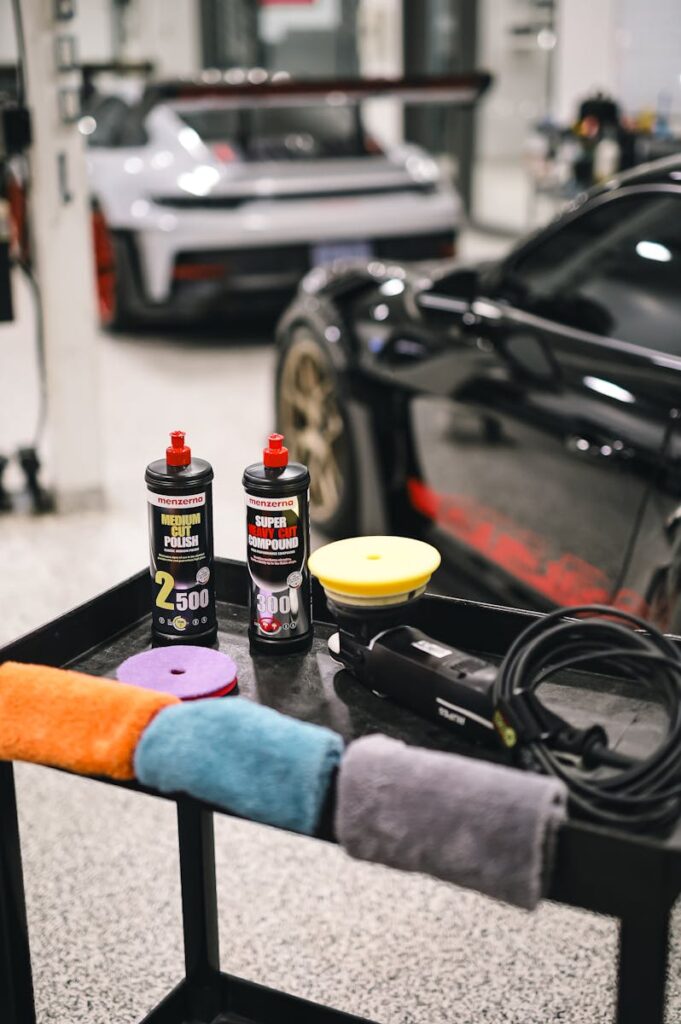
Photo by WAVYVISUALS on Pexels
Top Car Waxing Products Consider in 2025
Here is a selection of six highly rated car wax products, each designed to cater to various needs and preferences. Click the links to learn more or purchase them directly from their official websites.
Griot’s Garage Best of Show Paste Wax
Designed for show-stopping gloss, this paste wax is perfect for those who prioritize appearance. It’s loved for its deep, rich finish and quality protection.
Turtle Wax Super Hard Shell Paste Wax
A classic choice for strong protection and a high-gloss shine. This paste wax is known for its durability and ability to shield your car from the elements.
Meguiar’s Ultimate Liquid Wax
This synthetic polymer wax offers long-lasting protection, enhanced gloss, and excellent water-beading. Ideal for those seeking durability and ease of application.
Chemical Guys Butter Wet Wax
Perfect for car detailing enthusiasts, this liquid wax delivers a deep, wet-looking shine. It offers easy application and natural carnauba-based protection.
P21S Carnauba Wax
Renowned for its incredible shine, this natural carnauba wax provides a smooth finish without leaving any residue. It’s great for sensitive paint finishes.
Collinite No. 845 Insulator Wax
A favorite among car enthusiasts for its exceptional durability and protection. It works well across various climates and offers an impressive shine.
Each of these options has unique strengths, so assess your needs to find the best car wax for your vehicle and lifestyle. Make sure to follow the application instructions to achieve the best results!
Frequently Asked Questions
How long should I wait before washing my car after applying ceramic coating?
Most ceramic coatings require 24-48 hours before light washing and up to 7 days for full curing. Check your specific product instructions, as consumer-grade coatings may cure faster than professional formulations.
Can I use a car wash after waxing my vehicle?
Avoid automatic car washes for at least 48-72 hours after waxing. The harsh brushes and strong chemicals can damage or remove fresh wax before it fully cures. Hand washing remains the safest option for freshly waxed vehicles.
What happens if I wash my car too soon after waxing?
Washing too soon can disrupt the bonding process, resulting in uneven protection, reduced durability, and potential water spotting. The wax may streak or wash away entirely, requiring reapplication.
How can I tell when my car is ready to wash after coating? If your car has just been coated, it’s important to use the right tools when you begin washing it. For tips on picking the safest and most effective mitt, check out this guide on how to choose the best car wash mitt.
Most products are ready when water beads properly across the entire surface. If water sheets or doesn’t bead consistently, the coating may need more curing time.
Should I use different washing techniques for ceramic coated cars?
Ceramic coated vehicles can handle slightly more aggressive washing than traditional wax, but the two-bucket method and microfiber wash media remain best practices for preserving the coating.
Fusion Car Wash Packages
Fusion Car Wash offers a variety of wash packages tailored to meet different needs and budgets. Whether you’re looking for a basic clean or a comprehensive detailing treatment, there’s an option for everyone.
The packages typically range from express washes, ideal for a quick and efficient clean, to premium services that include interior vacuuming, hand waxing, and tire shine. Each package is designed to ensure your car remains spotless and protected while providing exceptional value. Additionally, Fusion Car Wash uses high-quality products and advanced techniques to deliver professional-grade results, leaving your car looking and feeling like new.
Achieving Long-Lasting Protection and Brilliant Shine
Successfully maintaining your vehicle’s protective coating requires understanding the delicate balance between cleanliness and preservation. Whether you’ve invested in traditional carnauba wax, synthetic formulations, or advanced ceramic coating, proper post-application care determines the success of your efforts.
The key lies in patience during the crucial curing period, followed by consistent maintenance washing with appropriate techniques and products. Quality protection systems reward careful application and maintenance with months or years of enhanced appearance and paint protection.
Remember that each product type has specific requirements for optimal performance. Take time to read manufacturer instructions, understand environmental factors that affect curing, and invest in quality maintenance products that complement your chosen protection system.
Your vehicle represents a significant investment that deserves proper care and protection. By following these guidelines and maintaining consistent care routines, you’ll preserve both the appearance and value of your vehicle while enjoying the satisfaction of a job well done.
Whether you choose professional services or tackle the job yourself, the principles remain the same: proper preparation, quality products, appropriate application techniques, and patient curing time create the foundation for outstanding results that last.

